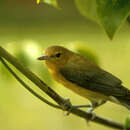en
names in breadcrumbs


Perception Channels: visual ; tactile ; acoustic ; chemical
Protonotaria citraea is listed as moderately vulnerable and is on the watch list of Partners in Flight. The placement of manmade breeding cavities in the U.S. would help populations expand. Conservation of mangroves along the coast in wintering regions would also rebuild the population, but no effort has yet been put into this cause (Petit 1999). This is a species of special concern in the state of Michigan.
US Migratory Bird Act: protected
US Federal List: no special status
CITES: no special status
State of Michigan List: special concern
IUCN Red List of Threatened Species: least concern
Protonotaria citrea is primarily insectivorous, feeding on flies, beetles, moths, butterflies, spiders, caterpillers, insect larvae, and an occasional snail or isopod. They have also been found to eat fruit and seeds. They forage for food in trees, branches, fallen logs, and leaves that are either on plants or dead and covering the ground. Using the bill to pick and probe, they hop along trees, logs and the ground in search for food. Protonotaria citrea will also catch food in an aerial or hovering manner, more often when caring for a nestling than not (Petit 1999).
During the breeding season the prothonotary warbler inhabits most of the United States, particularly central and southeastern states. Breeding occurs as far west as Texas, Oklahoma, and Kansas. To the east they can be found all along the Atlantic coast, stretching from northern Florida to southern New York. They also inhabit northern states such as Michigan and Wisconsin. Protonotaria citrea then travels south for the wintering season in Central America and parts of northern South America. They remain along the Atlantic coast from southern Mexico to South America. The prothonotary warbler will also winter along the Pacific coast of Costa Rica and Panama (Petit 1999).
Biogeographic Regions: nearctic (Native ); neotropical (Native )
Water is important to P. citrea and they spend their lives near or next to water formations of all kinds, such as lakes, creeks, swamps, and flooded forests. Occasionally they have been found living by swimming pools or house ponds. Protonotaria citrea are unique among warblers because they build breeding homes in pre-established cavities, made either naturally, by woodpeckers, or by man. Manmade cavities can be made out of milk cartons or small wooden boxes. Most cavities that are chosen are those in trees. While wintering most P. citrea live in the mangroves that line the coast of Central and South America. Many of these mangroves are being destroyed for the construction of coastal developement, highways, and agriculture. This destruction of Protonotaria citrea habitat has produced a decline in their population. The destruction of the forests in the United States is also a threat to this bird's habitat and life (Petit 1999).
Terrestrial Biomes: savanna or grassland ; forest ; rainforest
Average lifespan
Status: wild: 97 months.
Protonotaria citrea received its name because of its resemblance to the yellow hooded prothonotaries of the Roman Catholic Church. Coloration of P. citrea is a vibrant yellow on the head, neck, and underside. Yellow fades into olive green along its back and then to gray over the lower back and tail. The upperwings are a blueish gray with black at the tips and the underwings white and yellow. The belly fades from yellow to white, coloring the underside of the tail white. Female birds resemble males except they are duller in color, with more olive green tinting the yellow. Males have a black bill, while females have a black upper mandible and a flesh colored or brown lower mandable. Both males and females have dark grey legs and feet, and black eyes (Petit 1999; Terres 1980).
Range mass: 14.4 to 17.8 g.
Other Physical Features: endothermic ; bilateral symmetry
Average basal metabolic rate: 0.1994 W.
Pairing between male and female prothonotary warblers occurs during the breeding season shortly after spring migration from the south. The male usually arrives at the breeding destination before the female in order find one or more breeding cavities and establish territory around these cavities. He layers each cavity with moss and introduces the female to each cavity with a display. The female chooses her mate based on the quality or the number of cavities that he has produced. Once the female has decided, she finishes building the nest and begins laying her eggs. An average clutch is 4-5 eggs, which the female incubates for 12-14 days. The eggs hatch usually within 12 hours of each other and the newborn nestlings remain in the nest for the next 10-11 days. Both the female and the male bring the nestlings food during this time. The final day, the parents repeatedly show up at the cavity, irritable and without food, chirping for the nestlings to exit the cavity. Fledglings are watched and cared for during the next 35 days until they can feed and care for themselves (Petit 1999; Terres 1980).
Key Reproductive Features: iteroparous ; gonochoric/gonochoristic/dioecious (sexes separate); sexual ; oviparous
Average time to hatching: 13 days.
Average eggs per season: 5.